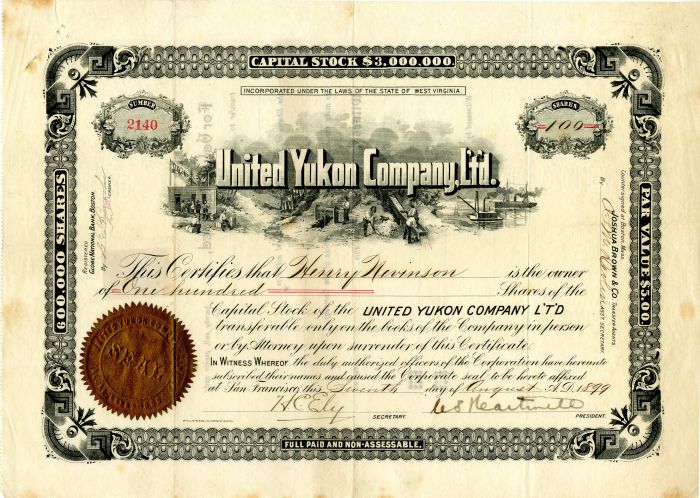United Yukon Co., Ltd. - Klondike Gold Rush Period - Alaska, West Virginia & Massachusetts Mining Stock Certificate
Inv# MS2615A Stock
California
West Virginia
Stock. Very Rare - Klondike Gold Rush Period. Measures 12" wide by 9" tall.
The Klondike Gold Rush was a migration by an estimated 100,000 prospectors to the Klondike region of the Yukon, in north-western Canada, between 1896 and 1899. Gold was discovered there by local miners on August 16, 1896; when news reached Seattle and San Francisco the following year, it triggered a stampede of prospectors. Some became wealthy, but the majority went in vain. It has been immortalized in films, literature, and photographs. To reach the gold fields, most prospectors took the route through the ports of Dyea and Skagway, in Southeast Alaska. Here, the "Klondikers" could follow either the Chilkoot or the White Pass trails to the Yukon River, and sail down to the Klondike.
The Canadian authorities required each of them to bring a year's supply of food, in order to prevent starvation. In all, the Klondikers' equipment weighed close to a ton, which most carried themselves, in stages. Performing this task, and contending with the mountainous terrain and cold climate, meant those who persisted did not arrive until summer 1898. Once there, they found few opportunities, and many left disappointed. To accommodate the prospectors, boom towns sprang up along the routes.
At their terminus, Dawson City was founded at the confluence of the Klondike and the Yukon Rivers. From a population of 500 in 1896, the town grew to house approximately 30,000 people by summer 1898. Built of wood, isolated, and unsanitary, Dawson suffered from fires, high prices, and epidemics. Despite this, the wealthiest prospectors spent extravagantly, gambling and drinking in the saloons. The Native Hän people, on the other hand, suffered from the rush; they were forcibly moved into a reserve to make way for the Klondikers, and many died. Beginning in 1898, the newspapers that had encouraged so many to travel to the Klondike lost interest in it.
In the summer of 1899, gold was discovered around Nome in west Alaska, and many prospectors left the Klondike for the new goldfields, marking the end of the Klondike Rush. The boom towns declined, and the population of Dawson City fell. Gold mining production in the Klondike peaked in 1903, after heavier equipment was brought in. Since then, the Klondike has been mined on and off, and today the legacy draws tourists to the region and contributes to its prosperity.
A stock certificate is issued by businesses, usually companies. A stock is part of the permanent finance of a business. Normally, they are never repaid, and the investor can recover his/her money only by selling to another investor. Most stocks, or also called shares, earn dividends, at the business's discretion, depending on how well it has traded. A stockholder or shareholder is a part-owner of the business that issued the stock certificates.









Ebay ID: labarre_galleries